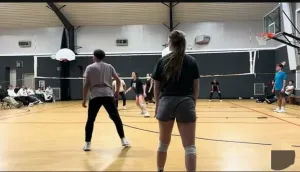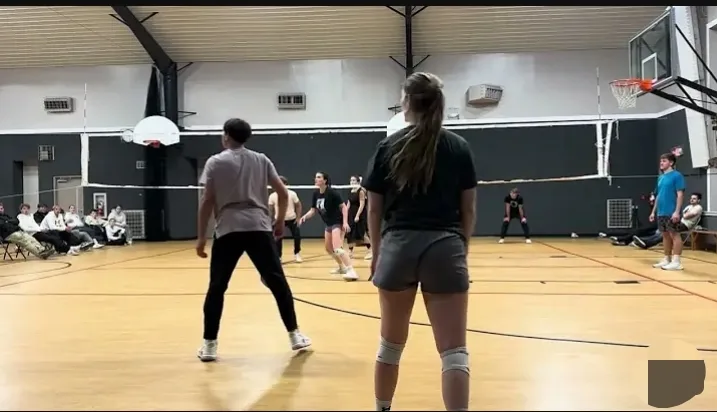Co-ed volleyball is a fantastic way for men and women to come together and enjoy the sport as a team. Unlike traditional volleyball, where teams consist only of men or women, co-ed volleyball encourages mixed-gender teams. This creates an exciting dynamic that adds a new level of challenge and camaraderie to the game. In this article, we’ll explore the rules, benefits, and tips for success in co-ed volleyball, making it easier for you to dive in and enjoy the sport.
What is Co-Ed volleyball?

At its core, co-ed volleyball is a version of volleyball where teams are composed of both men and women. This mixed-gender format promotes inclusivity and ensures that everyone can participate regardless of their gender. Coed volleyball is played in both recreational and competitive leagues, and it’s popular in schools, community centers, and beach volleyball tournaments.
For example, imagine joining a local co-ed volleyball league where teams are made up of three men and three women on the court at all times. This balanced team setup ensures that the game remains fair while allowing each player to contribute their unique skills.
Read more: Fort Worth Roster Co-ed Volleyball: Varsity Division Rules
Rules of Co-Ed Volleyball
When it comes to co-ed volleyball, the rules are mostly the same as traditional volleyball, but with a few important differences to ensure gender balance. Here’s a breakdown of the most common rules you’ll encounter in co-ed leagues:
- Team Composition: Teams are required to have an equal or near-equal number of male and female players on the court. A typical co-ed volleyball game might feature three men and three women on the court at once in a six-player format.
- Serving Rotation: Serving in co-ed volleyball follows the same rotation rules as in traditional volleyball, but the key is that both men and women take turns serving. No one gender dominates the court.
- Touch Rules: Some leagues require that at least one female player must touch the ball before it crosses the net. This ensures that both men and women stay active and involved in every play.
- Substitutions: Just like in regular volleyball, substitutions can be made, but the team must maintain the gender balance on the court. This rule keeps the game fair and aligned with the spirit of co-ed competition.
Read more: How Much Does a Professional Volleyball Player Make
Differences Between Co-Ed Volleyball and Traditional Volleyball
One of the biggest differences between co-ed volleyball and traditional volleyball is the team composition. The mixed-gender aspect introduces unique challenges and strategies to the game. For instance, male players often bring strength and powerful hits, while female players may excel in agility and precision. The key to success in co-ed volleyball is learning how to blend these strengths for maximum team effectiveness.
In co-ed volleyball, communication and cooperation are even more important. Each player has to adapt to their teammates’ skills and play styles, regardless of gender. This makes the game more dynamic and fosters a sense of unity and teamwork.
Read more: 10 Volleyball Facts You Should Know
Benefits of Co-Ed Volleyball
Playing coed volleyball comes with several benefits, both physically and socially. Here are some of the key advantages:
- Physical Fitness: Like all volleyball, co-ed volleyball helps improve strength, agility, and cardiovascular health. The fast-paced nature of the game keeps players on their toes, burning calories while having fun.
- Social Interaction: Co-ed volleyball is a great way to meet new people and build friendships. Since it’s a mixed-gender sport, it allows for diverse social interactions, making it easier to connect with others and create a supportive community.
- Teamwork: Co-ed volleyball encourages players to work together, regardless of gender. This fosters an environment of equality and mutual respect, which is key in both sports and life.
- Fun and Inclusivity: Co-ed volleyball is less about winning and more about having fun and including everyone. It’s an ideal sport for people looking to enjoy a recreational activity with friends or family.
Tips for Success in Co-Ed Volleyball
To excel in co-ed volleyball, teamwork and communication are vital. Here are a few tips to help you succeed:
- Communicate Clearly: Make sure to always talk to your teammates during the game. Call out who will take the ball or let your team know if you’re going for a block or dig.
- Adapt to Play Styles: Since men and women might have different playing strengths, be ready to adapt your strategy. For instance, a male player might go for a power spike, while a female player may aim for a well-placed tip. The balance between power and finesse often leads to success.
- Stay Positive: One of the best things about co-ed volleyball is its friendly and fun atmosphere. Encourage your teammates, stay positive, and enjoy the game. Winning is great, but having fun together is even better.
Read More: 18 Cute Volleyball Hairstyles for Girls and Men Volleyball Players
FAQs About Co-Ed Volleyball
1. What is the gender ratio in co-ed volleyball?
The typical rule for co-ed volleyball is that there must be an equal number of men and women on the court at all times. In a six-player format, this usually means three men and three women on the court. Some leagues allow slight variations, but gender balance is always required.
2. Can women and men play different roles in co-ed volleyball?
While men and women can excel in different aspects of the game, co-ed volleyball encourages all players to take on various roles, from serving to spiking to blocking. There are no strict rules that limit players by gender. Everyone is encouraged to play to their strengths.
3. How can I join a co-ed volleyball league?
Many community centers, schools, and sports organizations offer co-ed volleyball leagues. To join, you’ll typically need to sign up as a team or as an individual looking for a team. Registration fees and schedules vary, so it’s best to check with your local league for details.
4. Are there any special rules in co-ed volleyball?
Yes, some leagues may have special rules, such as requiring at least one touch by a female player before the ball crosses the net. These rules ensure that both genders remain actively involved in the game and contribute equally to the team’s performance.
5. What’s the best strategy for success in co-ed volleyball?
The best strategy is to focus on communication, teamwork, and leveraging the strengths of each player. Since co-ed volleyball requires a balance of skills, teams that work well together and understand each other’s play styles usually perform the best.
By following these tips and understanding the unique aspects of co-ed volleyball, you can enjoy this inclusive and exciting sport with friends and new teammates alike!




